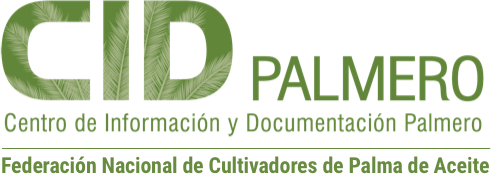| dc.creator | Oberthür, Thomas | |
| dc.creator | Arenas París, Carlos | |
| dc.date | 2019-12-19 | |
| dc.date.accessioned | 2020-07-25T11:22:02Z | |
| dc.date.available | 2020-07-25T11:22:02Z | |
| dc.identifier | https://publicaciones.fedepalma.org/index.php/palmas/article/view/13044 | |
| dc.identifier.uri | http://repositorio.fedepalma.org/handle/123456789/140923 | |
| dc.description | El manejo eficaz y eficiente de los fertilizantes es una parte importante para lograr rendimientos sostenibles en la palma de aceite, tanto a corto como a largo plazo. Si bien las decisiones sobre su manejo se toman rutinariamente como parte de la estrategia agronómica general, es preciso con- tar con una manera de monitorear el rendimiento para poder tomar decisiones futuras a medida que las condiciones biofísicas y económicas cambian. El uso de un conjunto de indicadores de rendimiento de nutrientes (NPI, por su sigla en inglés) puede proporcionar información a los ad- ministradores para dirigir las acciones futuras, así como dar retroalimentación sobre el desempeño comparativo de grupos al interior de la plantación. Utilizando los registros de plantaciones se puede derivar una selección de NPI, incluyendo la productividad por factor parcial (PPF por su sigla en inglés; la cantidad de producto por cada unidad de nutriente fertilizante empleado), el equilibrio parcial de nutrientes (PNB, por su sigla en inglés; la porción de nutrientes eliminados del producto, en comparación con la cantidad de nutriente fertilizante usada) y la eficiencia agronómica (AE, por su sigla en inglés; el aumento en el rendimiento, en comparación con la cantidad de nutriente fer- tilizante utilizada). De una plantación comercial en Borneo, con una media de rendimiento de 24,0 ± 4,6 t RFF/ha, la media de PPF-N fue de 174 ± 39 kg RFF/kg N, la de PPF-P de 750 ± 258 kg RFF/kg P y la de PPF-K de 85 ± 19 kg RFF/kg K. La media de PNB-N fue de 0,53 ± 0,12, la de PNB-P de 0,29 ± 0,10 y la de PNB-K fue de 0,33 ± 0,07. Estos datos se pueden desagregar para identificar los indicadores de desempeño por grupo de manejo de suelos y edad de la palma. Igualmente, los NPI se pueden monetizar considerando la relación entre el valor del producto y el costo del fertilizante. Aunque esta evaluación comparativa del desempeño de la plantación proporciona información a los administradores para el manejo de los nutrientes, es necesario realizar trabajos adicionales para cuantificar de mejor manera la relación entre el momento de suministro y el rendimiento, y el destino de los nutrientes no eliminados, como en el tejido de la palma o en el suelo. Así se puede obtener una mejor apreciación de la función de respuesta de frecuencia para la palma de aceite. | es-ES |
| dc.description | Effective and efficient fertilizer management is an important part of achieving sustainable yields in oil palm in both the short and long term. While decisions on the management of fertilizers are made routinely as part of the overall agronomic strategy, it is important to have a way to monitor nutrient performance so future decisions can be made as biophysical and economic conditions change. The use of a suite of nutrient performance indicators (NPI) can provide plantation managers with informa- tion to guide future management, as well as provide feedback on comparative performance of groups within the plantation. Using plantation records, a selection of NPI’s may be derived, including partial factor productivity (PFP, the amount of product for each unit of fertilizer nutrient used), partial nutrient balance (PNB, the amount of nutrient removed in the product compared to the amount of fertilizer nutrient used) and agronomic efficiency (AE, the increase in yield compared to the amount of fertilizer nutrient used). From a commercial plantation in Kalimantan, with a mean yield of 24.0±4.6 t FFB/ha, the mean PFP-N was 174±39 kg FFB/kg N, mean PFP-P was 750±258 kg FFB/kg P and mean PFP-K was 85±19 kg FFB/kg K. Mean PNB-N was 0.53±0.12, mean PNB-P was 0.29±0.10 and mean PNB-K was 0.33±0.07. These data can be disaggregated to identify performance indicators by soil management group, palm age, year and/or management group. As well, the NPI can be monetized by considering the ratio of value of the product to the cost of the fertilizer. Such benchmarking of plantation performance can provide managers with input to manage nutrients although there is further work to be undertaken to better quantify the relationship between the timing of nutrient supply to yield, the fate of nutrients not removed such as in palm tissue or in soil, and a better appreciation of the rate response function for oil palm. | en-US |
| dc.format | application/pdf | |
| dc.language | spa | |
| dc.publisher | Fedepalma | es-ES |
| dc.relation | https://publicaciones.fedepalma.org/index.php/palmas/article/view/13044/12867 | |
| dc.source | Revista Palmas; Vol. 40 Núm. Especial T (2019); 144-157 | es-ES |
| dc.source | 0121-2923 | |
| dc.subject | Partial nutrient balance | en-US |
| dc.subject | partial factor productivity | en-US |
| dc.subject | fertilizer efficiency | en-US |
| dc.subject | fertilizer effectiveness | en-US |
| dc.subject | benchmarking | en-US |
| dc.subject | equilibrio parcial de nutrientes | es-ES |
| dc.subject | productividad por factor parcial | es-ES |
| dc.subject | eficiencia de fertilizante | es-ES |
| dc.subject | efectividad de fertilizante | es-ES |
| dc.subject | evaluación comparativa | es-ES |
| dc.title | Indicadores de rendimiento de nutrientes en palma de aceite | es-ES |
| dc.title | Nutrient Yield Indicators in Oil Palm | en-US |
| dc.type | info:eu-repo/semantics/article | |
| dc.type | info:eu-repo/semantics/publishedVersion | |


